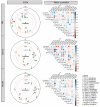Relationship between Behavioral and Objective Measures of Sound Intensity in Normal-Hearing Listeners and Hearing-Aid Users: A Pilot Study
- PMID: 35326347
- PMCID: PMC8946736
- DOI: 10.3390/brainsci12030392
Relationship between Behavioral and Objective Measures of Sound Intensity in Normal-Hearing Listeners and Hearing-Aid Users: A Pilot Study
Abstract
Background: For hearing-impaired individuals, hearing aids are clinically fit according to subjective measures of threshold and loudness. The goal of this study was to evaluate objective measures of loudness perception that might benefit hearing aid fitting. Method: Seventeen adult hearing aid users and 17 normal-hearing adults participated in the study. Outcome measures including categorical loudness scaling, cortical auditory evoked potentials (CAEPs), and pupillometry. Stimuli were 1-kHz tone bursts presented at 40, 60, and 80 dBA. Results: Categorical loudness scaling showed that loudness significantly increased with intensity for all participants (p < 0.05). For CAEPs, high intensity was associated with greater P1, N1, and P2 peak amplitude for all listeners (p < 0.05); a significant but small effect of hearing aid amplification was observed. For all participants, pupillometry showed significant effects of high intensity on pupil dilation (p < 0.05); there was no significant effect of hearing aid amplification. A Focused Principal Component analysis revealed significant correlations between subjective loudness and some of the objective measures. Conclusion: The present data suggest that intensity had a significant impact on loudness perception, CAEPs, and pupil response. The correlations suggest that pupillometry and/or CAEPs may be useful in determining comfortable amplification for hearing aids.
Keywords: cortical auditory evoked potential; hearing aid; loudness perception; objective measures; pupillometry.
Conflict of interest statement
The authors declare no conflict of interest.
Figures






Similar articles
-
Cortical auditory-evoked potentials (CAEPs) in adults in response to filtered speech stimuli.J Am Acad Audiol. 2013 Oct;24(9):807-22. doi: 10.3766/jaaa.24.9.5. J Am Acad Audiol. 2013. PMID: 24224988
-
Dynamics of infant cortical auditory evoked potentials (CAEPs) for tone and speech tokens.Int J Pediatr Otorhinolaryngol. 2013 Jul;77(7):1162-73. doi: 10.1016/j.ijporl.2013.04.030. Epub 2013 May 27. Int J Pediatr Otorhinolaryngol. 2013. PMID: 23722003 Free PMC article.
-
Effects of Amplification and Hearing Aid Experience on the Contribution of Specific Frequency Bands to Loudness.Ear Hear. 2019 Jan/Feb;40(1):143-155. doi: 10.1097/AUD.0000000000000603. Ear Hear. 2019. PMID: 29794566 Free PMC article.
-
Repeated Measurement of Absolute and Relative Judgments of Loudness: Clinical Relevance for Prescriptive Fitting of Aided Target Gains for soft, Comfortable, and Loud, But Ok Sound Levels.Semin Hear. 2017 Feb;38(1):26-52. doi: 10.1055/s-0037-1598064. Semin Hear. 2017. PMID: 28286363 Free PMC article. Review.
-
Relations among Auditory Brainstem and Middle Latency Response Measures, Categorical Loudness Judgments, and Their Associated Physical Intensities.Semin Hear. 2017 Feb;38(1):94-114. doi: 10.1055/s-0037-1598067. Semin Hear. 2017. PMID: 28286366 Free PMC article. Review.
Cited by
-
Emotional contagion to vocal smile revealed by combined pupil reactivity and motor resonance.Sci Rep. 2024 Oct 23;14(1):25043. doi: 10.1038/s41598-024-74848-w. Sci Rep. 2024. PMID: 39443497 Free PMC article.
-
Interaural speech asymmetry predicts bilateral speech intelligibility but not listening effort in adults with bilateral cochlear implants.Front Neurosci. 2022 Dec 7;16:1038856. doi: 10.3389/fnins.2022.1038856. eCollection 2022. Front Neurosci. 2022. PMID: 36570844 Free PMC article.
References
-
- Ruggero M.A., Rich N.C., Recio A. The Effect of Intense Acoustic Stimulation on Basilar-Membrane Vibrations. Audit. Neurosci. 1996;2:329–345.
Grants and funding
LinkOut - more resources
Full Text Sources
Medical

